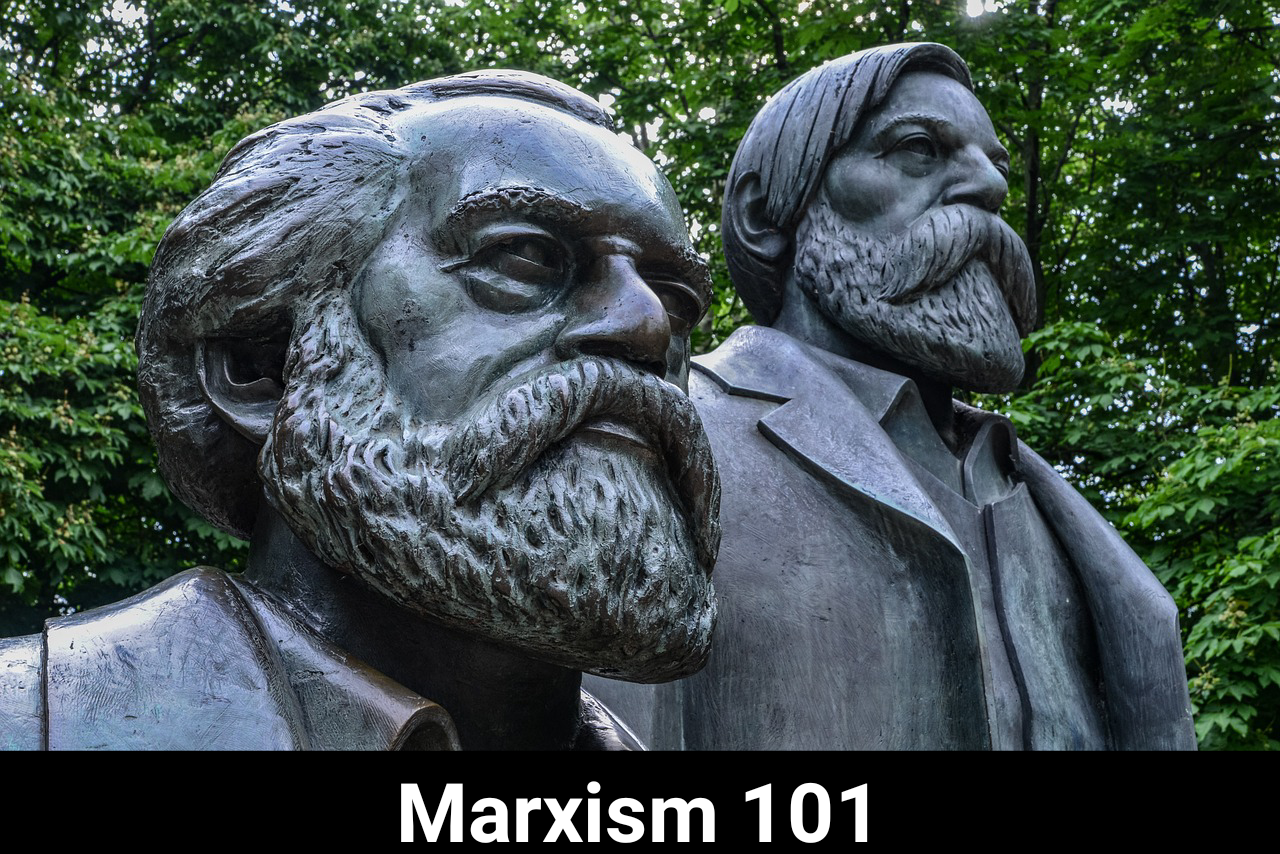Dialectical Materialism is the Marxist philosophical framework. Put another way, it’s the method we use to analyze the world.
Marxism doesn’t provide a set of dogmas that teach us how to act in all situations. But it does provide us a framework to use when analysing the problems we find before us.
Dialectical Materialism is what separates Marxism, aka Scientific Socialism, from utopian forms of Socialism, such as Anarchism.
Materialism
Marxists hold that before any phenomena can exist, matter has to exist in a form that would make it possible. Before there can be human consciousness or thought, there first has to be a materially existing human.
Marxists hold that there is an objective, material reality. That there is nothing unknowable, only things that are yet unknown. That given sufficiently advanced technology and education, we can test for and discover all things about the universe.
This is in opposition to the idealist world outlook, which asserts that spirit, thought, or some other unknowable force that’s outside of the material world, shapes material reality.
Marxists see our universe as a material phenomenon whose change is driven by its internal laws, rather than being something that’s acted upon from outside.
Dialectics
The metaphysician sees phenomena as isolated, static, and unchanging. The metaphysical understanding is that phenomena continually repeat themselves as the same thing, that they can increase or decrease in quantity but cannot change into a different thing.
In contrast, dialectics holds that all existence is interconnected, that phenomena effect, and are affected by, the things they interact with, and that all things are in a constant state of motion and change.
The development of the universe is driven by these internal interactions.
The internal nature of a thing determines the nature of its development
Each thing within the universe can be affected by external pressures but how a thing develops is determined from within. For example, sufficient heat can make a chicken egg hatch into a chicken, but no amount of heat can make a rock hatch into a chicken. Outside pressure can only feed into the contradictions that already exist inside a thing.
The law of contradiction
All phenomena are inherently unstable and are subject to change. Contradictory, opposing, forces exist within all things and between all things that interact with each other. As these opposing aspects push against each other, they drive the direction of motion and change.
For instance, the owner and workers in a business have opposing interests. The owner wants to pay their workers as little as possible while working them as hard as possible. Meanwhile, the workers want to receive the full value of their labour while working in humane conditions, with ample time off. The continuous struggle of the workers and owner against each other determines the ever changing working conditions and compensation that the workers receive, as well as how daily operations run.
This struggle between the owner and the workers will be affected by outside forces, such as legal protection for labour actions, health and safety laws, and minimum wage provisions. But while these factors will inform the outcome at any time, they don’t change the essential nature of the internal struggle within the company. The power struggle between the worker and owner is inherent to a privately owned company.
Instability is inherent in all things
No phenomena is stable and, given enough time, this competition between owner and workers will come to an end. Depending on how it plays out, the employees might buy the business and turn it into a worker co-op, the owner might shut it down because of its diminished profitability, the company might go bankrupt, or the workers might seize ownership of it as part of a wider socialist revolution.
Whatever happens though, one day the company will cease to exist as a privately owned business, because nothing is eternal. No phenomenon can exist forever.
The law of quantitative and qualitative changes
As the opposing aspects of a contradiction push against each other, one can win out, under the right circumstances, and suppress the other aspect. At that point the contradiction is resolved, or negated, and the phenomena transforms into a different thing. If heat reaches a certain level, water boils into steam. If the level of current flowing through a platinum wire becomes high enough, it makes the wire glow. The state of the thing suddenly changes to reflect the new dominant aspect.
In order to become dominant enough to suppress its opposite, an aspect has to increase quantitatively until it reaches that tipping point. While this can happen more quickly or slowly, as circumstances permit, it’s always a process of building development, where on the surface little appears to be happening.
When you heat water, it doesn’t appear to change as its temperature increases, until suddenly it starts to boil. Likewise, water appears static while you’re chilling it, until it reaches a tipping point and begins to freeze. In this way we see that changes in quantity lead to changes in quality, in moments of dramatic transformation.
Resolving a contradiction leads to new contradictions
When a contradiction is resolved or, to use another term, negated, it transforms into something new. This new phenomena, like all things, contains internal contradictions.
A single person wants romantic companionship but doesn’t have a willing romantic partner who they feel comfortable with. They resolve this contradiction by meeting someone and forming a romantic connection, but then they face a new contradiction: their needs and desires will never completely match their partner’s needs and desires. So they have to manage the relationship.
Negation of the negation
To the metaphysician, life repeats in cycles as the same thing. You’ve probably heard the saying that “history repeats itself.” In fiction you may have even heard the more extreme, literal notion that “all this has happened before,” that the universe is repeating the same history endlessly.
If we look at the protagonist from our relationship example, this might seem to be the case: the person was single, they entered a relationship, and when the relationship ends they will be single again.
Dialectics views development as happening in spirals though. The person coming out of the relationship is indeed single again, but they’re not the same person who entered the relationship: the experience has changed them.
To look at an economic example: people started off in a state of primitive communism, where hunter gatherers shared all property communally. Then private property arose with the division of labor, and ownership has remained divided between different people throughout the history of class society. When we take communal ownership of the economy again, we’ll have returned to a state of communism, but not the primitive communism where people lived in poverty and struggled to survive, it will be a communism with a highly developed economy that can provide for the population in abundance.
Development happens in spirals, returning things to states that resemble previous situations but which have developed into new, higher forms.
Primary and secondary contradictions
In analysing a complex situation, there are bound to be multiple contradictions at play. The primary contradiction is the main, overarching contradiction in a given situation or system. In the context of class based society, it’s the main conflict between opposing classes. For example, the primary contradiction in capitalist societies is between the bourgeoisie (owners of the Means of Production) and the proletariat (those who must work for a wage).
Secondary contradictions are the smaller, subsidiary contradictions that arise within the main contradiction or independently of it. They might not be as central as the primary contradiction, but they still play a role in the overall dynamics and changes of a situation.
In our example of a capitalist society, a secondary contradiction could be conflicts within the working class, like differences between skilled and unskilled workers, and the oppression of racialized people to the benefit of white people, and of women to the benefit of men.
It can still be important to address secondary contradictions in our efforts to resolve the primary contradiction. For instance, standing up for queer rights can slow the growth of the reactionary movement, save lives, and help to show queer people that we’re on their side, winning us potential allies to fight for class liberation.
At times, secondary contradictions can rise to become the primary contradiction and be the decisive factor in the direction of change. For instance, in Weimar Germany, the contradiction between liberal democracy and fascism rose to become the primary contradiction. The victory of fascism handed immense power to the capitalist class.
The primary and secondary aspect of a contradiction
Every contradiction is made up of a unity of opposites: night and day, lord and serf, predator and prey, capitalist and proletarian, socialised production and private ownership of production. But these two aspects are rarely in equilibrium, and even when they are it’s only temporary.
One aspect in the contradiction inevitably becomes dominant or primary, and that shapes the nature of the phenomenon. In the era of bourgeois (capitalist) rule, the capitalists are the dominant aspect, and their domination of society shapes the whole of economic and social life.
In times of revolutionary organising though, the proletariat can become the dominant aspect. And if it becomes dominant enough, it can negate the whole contradiction, bringing in an era of socialism. This is because contradictions continue to develop over time.
In analyzing a phenomenon, we should pay attention to the dominant aspect of the contradiction, as it determines the nature of the contradiction. But we should also pay attention to that which is arising and developing, so that we can judge the future direction of change.
There is always something arising and developing and always something dying away. The rising aspect determines the direction of change.
The general and the particular
The universality of contradictions means that we can study the contradictions in and between individual things to gain a concrete understanding of a particular situation. For instance, we can study many aspects of a particular business to understand what’s happening in that business.
Through our investigation of particular things, we can formulate general rules about similar phenomena, giving us a general understanding about types of things. If we properly study five textile firms, for example, we can learn how textile firms operate in general, and what specific contradictions they face.
If we study businesses in a range of industries, we can formulate an understanding of how businesses operate in general.
This is an eternal cycle of refinement, where we continually test and refine our ideas, leading to an ever more sophisticated understanding.
With our general understanding of how businesses operate, we’re now in a much better position to efficiently analyse businesses in the future and come to correct conclusions.
In all instances, though, we should study individual situations concretely, where possible, instead of operating only based on general laws about a type of phenomena. Without investigation of individual situations, we’re much less likely come to correct conclusions.
Recommended reading:
Dialectical and Historical Materialism by Joseph Stalin
On Contradiction by Mao Zedong
Return to: Marxism 101 Course





